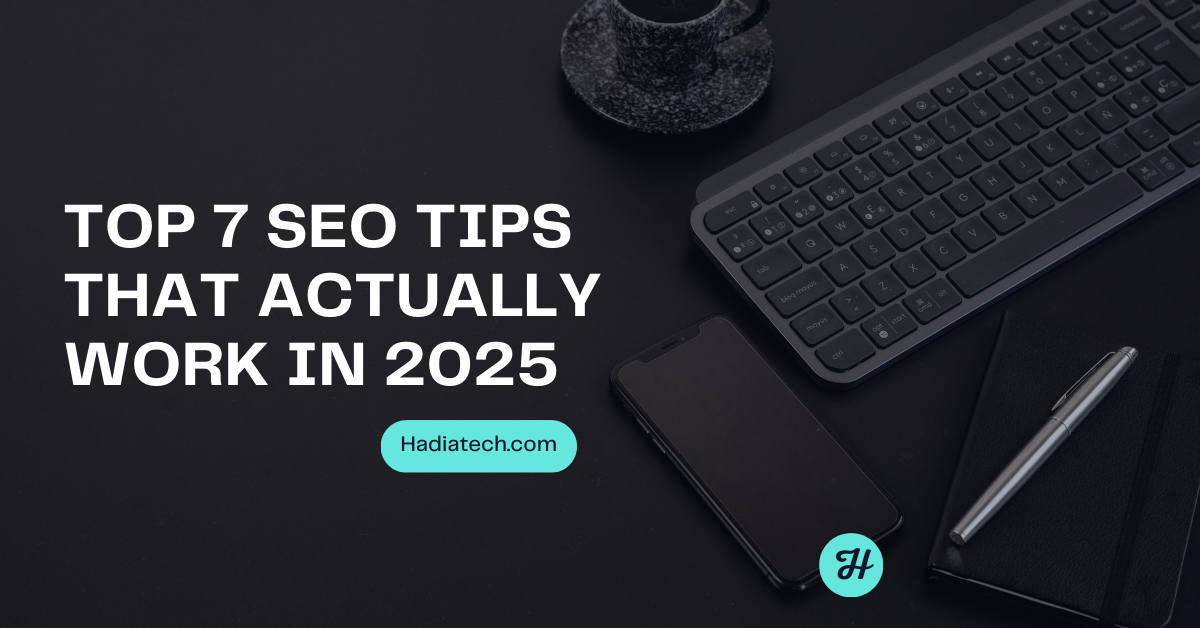Top 7 SEO Tips That Actually Work in 2025
Introduction
If you’re trying to grow your website traffic in 2025, there’s no getting around it: SEO is still king. But it’s not the same game it was a few years ago. With Google’s algorithm getting smarter and more user-focused, the strategies that worked in 2020 won’t cut it anymore. SEO in 2025 is all about aligning with user behavior, intent, and experience.
Here, I’m going to walk you through 7 genuine SEO tips that work – no hype, no garbage hacks. Just tested-and-proven techniques that’ll send you soaring up the rankings, more clicks, and keep you in front of the crowd.
1. Think About Search Intent, Not Keywords
Let’s make one thing certain: keywords alone will not rank you. In 2025, Google is highly focused on why a human is searching — not just what they’re typing. This is called search intent.
There are three primary categories:
- Informational: The user wants to know something (“how to bake a cake”)
- Transactional: The user wants to buy (“buy wireless headphones”)
- Navigational: The user is asking for a specific page (“Facebook login”)
Example: When someone types in “best running shoes,” they’re not looking for a history of running shoes. They require product suggestions, reviews, and a smooth way to purchase. That’s transactional intent.
Aligning your content to intent doesn’t only increase your click-through rate (CTR) but also retains users for longer — two strong ranking signals.

2. Optimize for Core Web Vitals
Page performance and speed matter more than ever. Google prioritizes three key Core Web Vitals that measure user experience:
- LCP (Largest Contentful Paint): Verifies load time
- FID (First Input Delay): Verifies interactivity
- CLS (Cumulative Layout Shift): Verifies visual stability
In plain terms: your site needs to be quick to load, responsive, and not wiggly during loading.
- Testing tools and improvers:
- Google PageSpeed Insights
- GTmetrix
- Web.dev
It all means better engagement, fewer bounces, and improved rankings.
3. Revive Old Content Strategically
SEO is as much about revitalizing what you have as it is about publishing new content.
Blog entries naturally age over time. Stats are outdated, links are broken, and the competition publishes newer entries. That’s where content decay happens.
Fix it by:
- Updating outdated facts and adding in fresh stats
- Rewriting headings and intros
- Adding internal links to fresh content
- Fixing broken links and styling
Google likes fresh content — especially if it’s already been crawled and has some history. Refreshing content is one of the easiest grey-hat ways to boost rankings without having to begin from scratch.

4. Write Naturally with Long-Tail Keywords
Long-tail keywords are more specific, longer phrases that people search for. Use “best budget DSLR camera for beginners” instead of just “DSLR camera.”
Why they’re important in 2025:
- Less competition
- Better conversion rates
- Easier to rank
Use them naturally in your subheadings, FAQs, image alt texts, and body content.
Example: Instead of stuffing “cheap laptops” all over your blog, write: “If you’re looking for the best cheap laptops under $500 for school or work, here are some solid picks.”
5. Structure Your Content Like a Pro
Formatting is important — to readers and Google. A well-organized post holds people’s attention and indicates relevance to Google.
Do this:
- Use clean H1, H2, and H3 headings
- Keep paragraphs 2–4 lines max
- Use bullet points and numbered lists
- Add images where needed (images, charts, infographics)
Take it to the next level? SurferSEO and Frase.io are tools that help you optimize structure and keyword placement from top-ranking sites.
6. Acquire Quality Backlinks (Not Any Link)
Not all backlinks are created equal. One high-quality backlink from a reputable site can outshine dozens of directory links that aren’t so good.
Don’t spam. Try instead:
- Guest posting on relevant blogs
- HARO (Help a Reporter Out) to get name-checked in stories
- Content backed up by data that others will be happy to cite
Pro tip: Build relationships before backlinks. It’s worth getting to know editors and bloggers in the long term.
7. Optimize for Featured Snippets
Featured snippets are those short answers Google shows at the top of search results. Landing here can skyrocket your visibility — even if you’re not ranked #1.
To win snippets:
- Use Q&A format for key queries
- Add clear definitions or step-by-step instructions
- Use bullet lists or tables when possible
Example:
Question: What is on-page SEO?
Answer: On-page SEO is the process of optimizing one web page for better search engine ranking. It involves content, title tags, internal linking, and HTML source code.
Bonus Tip: Don’t Forget UX
User experience is no longer a choice. Google now uses good UX as a ranking signal.
Make sure your site:
- Has a simple, easy-to-use structure
- Is fully mobile-friendly
- Doesn’t contain intrusive pop-ups and autoplay videos
- Utilizes easy-to-read fonts and spacing
- Good UX = longer sessions = higher rankings.
Conclusion
There’s no magic wand for SEO, but these 7 tips are as close as it gets in 2025. They’re practical, proven, and built around what Google and users actually want.
Start by applying just one or two of these techniques this week. Over time, they’ll compound — and you’ll start to see your traffic climb.
Stay consistent, stay up to date, and always prioritize first. That’s the real SEO game.
Ready to take your SEO to the next level? Start optimizing now and let the results speak for themselves.




